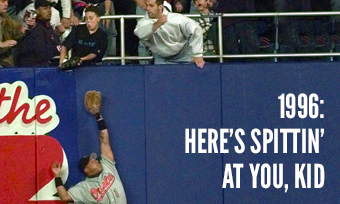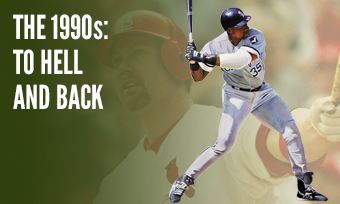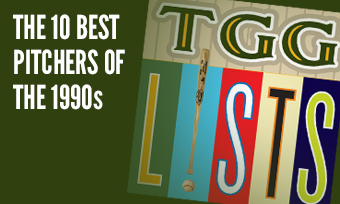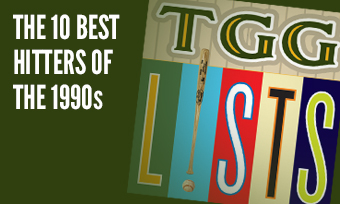The Yearly Reader
Leaders and Honors, 1996
Our list of baseball’s top 10 hitters and pitchers in both the American League and National League for the 1996 baseball season, as well as the awards and honors given to the game’s top achievers of the year.
The National League’s Top 10 Hitters, 1996
Bold type in brick red indicates league leader.
1. Ellis Burks, Colorado
Key Numbers: .344 average, 142 runs, 211 hits, 45 doubles, 8 triples, 40 home runs, 128 RBIs, 32 stolen bases, .639 slugging percentage.
Almost out of nowhere, Burks became a mile-high monster after a pair of nondescript campaigns with the Rockies; he would never score or knock in 100 runs in any other of 17 major league seasons.
2. Barry Bonds, San Francisco
Key Numbers: .308 average, 122 runs, 27 doubles, 42 home runs, 129 RBIs, 151 walks, 30 intentional walks, 40 stolen bases.
Neither his father (Bobby Bonds) nor godfather (Willie Mays) could do it, but Bonds achieved 40 homers and 40 steals in the same year.
3. Gary Sheffield, Florida
Key Numbers: .314 average, 118 runs, 33 doubles, 42 home runs, 120 RBIs, 142 walks, 10 hit-by-pitches, 16 stolen bases, .465 on-base percentage.
Like Forrest Gump’s box of chocolates, you never knew what you were going to get from the hot-and-cold Sheffield. In 1996, the Marlins got plenty, from power (the home runs) to patience (the walks) to pique (a major league-high five ejections).
4. Jeff Bagwell, Houston
Key Numbers: 162 games, .315 average, 111 runs, 179 hits, 48 doubles, 31 home runs, 120 RBIs, 135 walks, 10 hit-by-pitches, 21 stolen bases.
Four of Bagwell’s career-high (and then-Houston record) 48 doubles came in a June 14 game at San Francisco; no other Astro has collected more than three in any contest.
5. Andres Galarraga, Colorado
Key Numbers: .304 average, 116 runs, 190 hits, 39 doubles, 47 home runs, 150 RBIs, 157 strikeouts, 17 hit-by-pitches, 18 stolen bases.
The Big Cat (with all due apologies to Johnny Mize) set a Rockies season RBI record that still stands—with 103 of them at Coors Field alone.
6. Ken Caminiti, San Diego
Key Numbers: .326 average, 109 runs, 178 hits, 37 doubles, 40 home runs, 130 RBIs, 11 stolen bases, 10 sacrifice flies.
Caminiti would ultimately fess up to his NL MVP-winning, career-peak performance by confirming he was on steroids.
7. Dante Bichette, Colorado
Key Numbers: .313 average, 114 runs, 198 hits, 39 doubles, 31 home runs, 141 RBIs, 31 stolen bases, 10 sacrifice flies.
Bichette came within one RBI of joining Andres Galarraga with 100 just at Coors Field—but did join Galarraga (and Ellis Burks) as the second trio of teammates with 40-plus homers in a season. (The Rockies would do it again the following season, with Larry Walker replacing Bichette.)
8. Barry Larkin, Cincinnati
Key Numbers: .298 average, 117 runs, 32 doubles, 33 home runs, 89 RBIs, 96 walks, 36 stolen bases.
The reigning NL MVP splurged on strength with a surprising 33 homers, joining once-and-current teammate Eric Davis (who returned to the Reds after five years elsewhere) as the only players in Cincinnati history to go 30-30.
9. Bernard Gilkey, New York
Key Numbers: .317 average, 108 runs, 181 hits, 44 doubles, 30 home runs, 117 RBIs, 17 stolen bases.
It was easy to smell a jack rabbit as offense rose to even more ridiculous heights, as Gilkey more than proved with 30 homers after rarely hitting more than 10 before or since.
10. Chipper Jones, Atlanta
Key Numbers: .309 average, 114 runs, 185 hits, 32 doubles, 5 triples, 30 home runs, 110 RBIs, 87 walks, 14 stolen bases.
Labeled “Blue-Chipper” in the minors for his promising future, Jones overcame early disruptions from major injury to make the A-list grade.
The American League’s Top 10 Hitters, 1996
1. Alex Rodriguez, Seattle
Key Numbers: .358 average, 141 runs, 215 hits, 54 doubles, 36 home runs, 123 RBIs, 15 stolen bases.
Rodriguez decided to shorten his swing in spring training and control his wildness; the results spoke for themselves as A-Rod went from 19-year-old part-timer in 1995 to instant All-Star and oh-so-close MVP (losing first place by three points to Texas’ Juan Gonzalez) in 1996.
2. Albert Belle, Cleveland
Key Numbers: .311 average, 124 runs, 187 hits, 38 doubles, 48 home runs, 148 RBIs, 99 walks, 11 stolen bases, 20 grounded into double plays.
Belle led the charge for a Cleveland offense that became the first since the Tigers of the 1930s to hit over .290 as a team for the third straight year.
3. Ken Griffey Jr., Seattle
Key Numbers: .303 average, 125 runs, 26 doubles, 49 home runs, 140 RBIs, 16 stolen bases.
Putting an injury-marred (broken wrist) off-year behind him, Griffey began a thunderous run averaging 50 homers over each of the next four seasons.
4. Mark McGwire, Oakland
Key Numbers: 130 games, .312 average, 104 runs, 52 home runs, 113 RBIs, 116 walks, .467 on-base percentage, .730 slugging percentage.
After much prodding and guilt, McGwire would later confess to steroids—and that likely explains how he could miss 32 games and still rout 52 home runs.
5. Frank Thomas, Chicago
Key Numbers: .349 average, 110 runs, 184 hits, 26 doubles, 40 home runs, 134 RBIs, 109 walks, 26 intentional walks, 25 grounded into double plays.
Thomas reached base in a ML-record 97.2% of the games he played.
6. Mo Vaughn, Boston
Key Numbers: .326 average, 118 runs, 207 hits, 29 doubles, 44 home runs, 143 RBIs, 95 walks, 154 strikeouts, 14 hit-by-pitches.
Mo’ Better Bruise followed up his AL MVP effort of 1995 with even better output, but the Red Sox didn’t make the playoffs, so…no second honor.
7. Jim Thome, Cleveland
Key Numbers: .311 average, 122 runs, 28 doubles, 5 triples, 38 home runs, 116 RBIs, 123 walks.
After smelling stardom for five years, Thome exploded into Hall-of-Fame form with his first of nine straight years hitting at least 30 home runs.
8. Chuck Knoblauch, Minnesota
Key Numbers: .341 average, 140 runs, 197 hits, 35 doubles, 14 triples, 13 home runs, 72 RBIs, 98 walks, 19 hit-by-pitches, 45 stolen bases.
Knoblauch felt the need to pick up an already strong pace after Kirby Puckett’s unexpected preseason retirement; four of his AL-high 14 triples came in a pair of games with two each, both against Kansas City.
9. Brady Anderson, Baltimore
Key Numbers: .297 average, 117 runs, 172 hits, 37 doubles, 5 triples, 50 home runs, 110 RBIs, 22 hit-by-pitches, 21 stolen bases.
The statistical insanity of 1996—and quite possibly that of the entire Steroid Era—can be best summed up in four words: Brady Anderson, 50 homers.
10. Edgar Martinez, Seattle
Key Numbers: 139 games, .327 average, 121 runs, 52 doubles, 26 home runs, 103 RBIs, 123 walks.
Still the toughest out on a venerable Seattle offense that now included both Ken Griffey Jr. and Alex Rodriguez, Martinez was one of four Mariners to score over 100 runs—thus pushing the team’s total to just seven short of 1,000.
The National League’s Top 10 Pitchers, 1996
1. Kevin Brown, Florida
Key Numbers: 1.89 ERA, 17 wins, 11 losses, 32 starts, 3 shutouts, 233 innings, 33 walks, 16 hit-by-pitches, 26 grounded into double plays.
Brown escaped the AL offensive orgy and ended Greg Maddux’s three-year reign as NL ERA leader.
2. John Smoltz, Atlanta
Key Numbers: 2.94 ERA, 24 wins, 8 losses, .750 win percentage, 35 starts, 253.2 innings, 276 strikeouts.
Pitching his way to 14 straight wins after losing his first start, Smoltz enjoyed his one great year among many good ones.
3. Greg Maddux, Atlanta
Key Numbers: 2.72 ERA, 15 wins, 11 losses, 35 starts, 245 innings, 28 walks, 11 intentional walks, 21 stolen bases allowed, 24 grounded into double plays.
A disappointment by Mad Dog’s standards, easily the least impressive of an über-impressive five-year stretch in which he otherwise would go 72-21 with a 1.93 ERA—and yet, here he was, near the top of the charts.
4. Tom Glavine, Atlanta
Key Numbers: 2.98 ERA, 15 wins, 10 losses, 36 starts, 235.1 innings, 20 grounded into double plays.
Along with John Smoltz and Greg Maddux, Glavine continued to do his bit to keep the Braves’ Big Three sound.
5. Al Leiter, Florida
Key Numbers: 2.93 ERA, 16 wins, 12 losses, 33 starts, 215.1 innings, 119 walks, 11 hit-by-pitches, 23 grounded into double plays.
Shunned of the spotlight in Miami by Kevin Brown, Leiter had to scrape for attention even on the no-hitter front—dialing up the least memorable of three on the year. (The other two were Dwight Gooden’s comeback no-no for the Yankees, and Hideo Nomo’s improbable gem at offensively-fueled Coors Field.)
6. Trevor Hoffman, San Diego
Key Numbers: 2.25 ERA, 9 wins, 5 losses, 42 saves, 7 blown saves, 70 appearances, 88 innings.
The Marlins were certainly happy to have Gary Sheffield (especially in 1996), but they were started to regret giving up Hoffman, who broke out into his Cooperstown groove, to get him in 1993.
7. Robb Nen, Florida
Key Numbers: 1.95 ERA, 5 wins, 1 loss, 35 saves, 7 blown saves, 75 appearances, 83 innings.
For now, the Marlins were less rueful over the Hoffman trade thanks to the emergence of Nen, son of late 1960s part-time infielder Dick Nen.
8. Shane Reynolds, Houston
Key Numbers: 3.65 ERA, 16 wins, 10 losses, 35 starts, 239 innings, 44 walks.
The rising Astros star eyed 20 wins in August, but ended up failing to win either of his last seven starts.
9. Mel Rojas, Montreal
Key Numbers: 3.22 ERA, 7 wins, 4 losses, 36 saves, 4 blown saves, 74 appearances, 81 innings.
Though not dominant nor lasting a closer as some of the other sensational stoppers emerging on the scene, Rojas rose to the occasion for a still-competitive Expos team—allowing just two earned runs over the final 31 innings of the season with 21 saves after July 24.
10. Jeff Fassero, Montreal
Key Numbers: 3.30 ERA, 15 wins, 11 losses, 34 starts, 231.2 innings.
Sandwiched between a mediocre start and mediocre finish, Fassero was 10-2 with a 2.18 ERA from the start of June through late August.
The American League’s Top 10 Pitchers, 1996
1. Pat Hentgen, Toronto
Key Numbers: 3.22 ERA, 20 wins, 10 losses, 35 starts, 10 complete games, 3 shutouts, 265.2 innings, 24 grounded into double plays.
Hentgen rebounded from an awful 1995, doubling his win total and halving his ERA while rightfully (but narrowly) earning AL Cy Young honors over popular favorite Andy Pettitte.
2. Ken Hill, Texas
Key Numbers: 3.63 ERA, 16 wins, 10 losses, 35 starts, 3 shutouts, 250.2 innings, 4 balks, 14 caught stealing/picked off, 26 grounded into double plays.
Bouncing around from one team to another, Hill briefly found success in Arlington, anchoring an otherwise subpar (5.18 ERA) rotation.
3. Charles Nagy, Cleveland
Key Numbers: 3.41 ERA, 17 wins, 5 losses, .773 win percentage, 32 starts, 222 innings, 26 grounded into double plays.
You can almost copy and paste Ken Hill’s remarks here for Nagy, who (not so briefly) found success in Cleveland—anchoring an otherwise subpar (4.94) rotation.
4. Andy Pettitte, New York
Key Numbers: 3.87 ERA, 21 wins, 8 losses, .724 win percentage, 34 starts, 221 innings, 23 grounded into double plays.
Amid a star-studded Yankees rotation (Dwight Gooden, David Cone, Jimmy Key, Kenny Rogers, etc.), the second-year Pettitte showed them how it was done with a career-high total of triumphs.
5. Alex Fernandez, Chicago
Key Numbers: 3.45 ERA, 16 wins, 10 losses, 35 starts, 258 innings, 20 grounded into double plays.
In his last year at Chicago before signing with the ‘let’s-win-now’ Marlins, Fernandez served as the rock of the White Sox rotation, responsible for six of the team’s seven complete-game efforts.
6. Roberto Hernandez, Chicago
Key Numbers: 1.91 ERA, 6 wins, 5 losses, 38 saves, 8 blown saves, 72 appearances, 84.2 innings.
Working as well together as their names rhyme, Hernandez effectively closed out what Alex Fernandez started more than a few times during the year for the White Sox.
7. Juan Guzman, Toronto
Key Numbers: 2.93 ERA, 11 wins, 8 losses, 27 starts, 187.2 innings.
While Pat Hentgen racked up the wins for the Blue Jays, Guzman—who finally began to quell his early-career wildness—kept them from scoring more efficiently than any other AL pitcher.
8. Kevin Appier, Kansas City
Key Numbers: 3.62 ERA, 14 wins, 11 losses, 32 starts, 211.1 innings, 10 wild pitches, 21 grounded into double plays.
While the Royals began to sink into the AL abyss for the long haul, the eighth-year Appier constantly reminded them of better days gone by.
9. Mariano Rivera, New York
Key Numbers: 2.09 ERA, 8 wins, 3 losses, 5 saves, 3 blown saves, 61 appearances, 107.2 innings, 88 total bases allowed.
Momentarily the set-up guy to John Wetteland, the second-year Rivera served notice of a bright future by pitching 27 straight scoreless innings from mid-April to late May.
10. John Wetteland, New York
Key Numbers: 2.83 ERA, 2 wins, 3 losses, 43 saves, 4 blown saves, 62 appearances, 63.2 innings.
The one-time Expo was once lauded by Yankees boss George Steinbrenner for flourishing in a small-market environment. Now, as Montreal baseball whittled away, he was New York’s.









